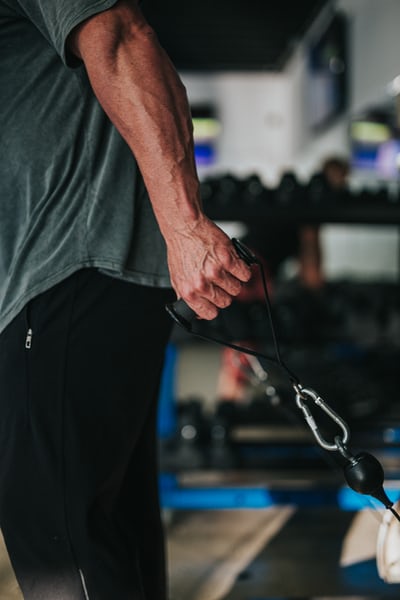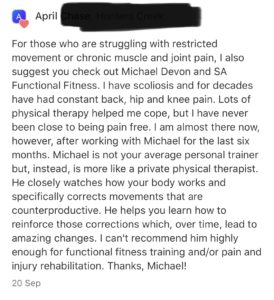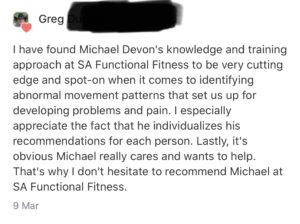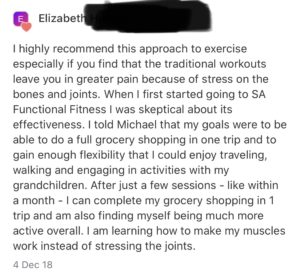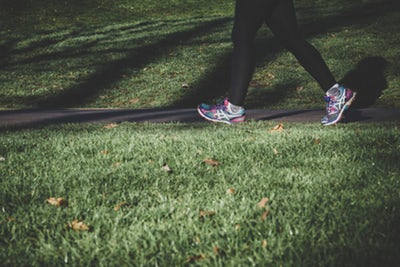No it’s not just that your losing weight (that’s mostly diet anyway), or that you’re lifting more weight, or you can touch your toes. All of that should come along for the ride, but what if all of that happens at the expense of your well-being, and you can lift more weight but you blow out your knee joints, or shoulder joints, or you’re losing weight by beating your body up with chronic fast paced interval workouts that you won’t be able to sustain when your body finally crashes (hence why dietary habits are more important for sustainable weight loss), or you’re more flexible but touching your toes is over stretching your hamstrings and now you can’t contract them like you should and they no longer support your body.
The way our trainers educate our clients to know if their workouts are actually yielding a return on their investment is if they’re able to move without guarding or restriction, they no longer have chronic pain when they exercise or move about in the real world, and they can function the way they need and want to without having to avoid certain activities. Of course all of this is a process and not an overnight event, but those are the goals our trainers have for all of our clients, our intentions behind every workout is to build muscle and strength that carries over to life away from the gym. After all, the gym shouldn’t be where you spend hours a day but instead get in, do your work, and get out to enjoy other activities that our gym has prepared your body for!
We are a unique boutique fitness studio that focuses on human biomechanics and our niche does’t entertain all the fluff in the fitness industry because we’ve been there and we’ve done that, and we finally realized that it was ego driven and unsustainable. We beat our bodies up at the expense of looking good, and we realized that if we continued on that path, we’d be right where the rest of gym goers were, wearing knee braces, avoiding certain lifts because it hurt, working around problems, on the path to knee replacements and back surgeries, and eventually blaming old age on a problem that was created years prior from bad fitness habits. We realize not everyone is about longevity and sustainability but for those of you who want something different, and something that will last, we’re here for you!
Once we can undo the damage done to your body from past exercise habits and old injuries, then the fun can start and you can obtain that rush of endorphins and the higher intensity cardiovascular workouts but you won’t injure yourself because your body will have been primed for advanced movements. And if it’s not, your body will tell you and we’ll stop and correct what needs correcting before blindly proceeding with an exercise that you might need more coaching on. The difference is by that point you and your body will know what feels right and what is going to produce damage, because we like to educate you along the way so that you learn the purpose of an exercise and how it should carry over to your overall function- inside and outside of the gym.
We spend time in the beginning learning foundational concepts to apply to basic exercises that involve structures like your pelvis and ribcage, that effect other structures like your arms, shoulders, and neck, as well as your legs, knees, ankles, and feet. When you learn the functions of these structures and how to move them to contract muscles and then what those muscle contractions should feel like, then we can go on to the next level. We don’t like to get ahead of ourselves or rush your progress, but we do want to push you to get your body functioning the way it needs to be. How ever long it takes, we have patience to safely progress you and ensure we aren’t going to force you into exercises your body isn’t ready for. As we keep moving you through the levels, that’s when efficiency starts to manifest and we are able to make the most of your time in the gym. Rather than keeping you in a routine that works on stretching first, then strength training, then cardiovascular exercises, then core strengthening, then mobility, then endurance and time under tension, we are able to do all of that at once. Not in one workout but in one exercise! Then not only does your time become efficient but so does your body and the way it moves.
Efficiency is key because in the real world your brain and body don’t have time to think of how to move, it just happens automatically. So the idea of mentally “squeezing” a muscle breaks down at some point and your body needs to learn how to contract a muscle by positioning your bones at the correct angles. Don’t worry, we teach you this. And we take it a step further by matching those angles to the angles that replicate basic human movements like standing, walking, running, bending over, and even throwing, so when you go to perform these movements, you don’t have to think because your muscles already know how to contract during those functions. Again, all of this takes time, depending on how dysfunctional your body has become from improper exercise habits, arbitrary workout classes, old injuries, chronic pains, and whatever else we have to fix to start retraining the brain and body to connect better.
If you’re local to San Antonio and the surrounding areas, we’re your future gym. Not to toot our own horn (because we’re humbled everyday by unique cases like scoliosis clients, clients with chronic pain that hasn’t been helped by physical therapy so they turn to us as their last ditch effort, and other problems that the fitness industry prefers to avoid or work around), but we’re the only place that trains this way. Sure other gyms might claim to do this or have the same intentions, but chances are they are not providing the same service and techniques. The human biomechanics field is a very small, up and coming one, and the Functional Patterns institute that teaches these techniques doesn’t promote weekend or online training seminars, but instead we spend weeks learning these methods to ensure that first, we get them right, so we can properly teach our clients.
So, stop getting stuck in the stretch, lift, cardio, stretch routine and start learning how to become more efficient with exercise, to become more efficient in the real world. Contact us today to schedule an initial consultation/ evaluation and learn what your body does well so we can build off of that, and also what it doesn’t do well so we can correct that! You have your entire life ahead of you, are you going to spend it in pain and unable to move like you used to (what your doctor says is just old age) or are you going to do something about it? It’s time to regain your freedom to move and take control of your lifestyle and the way the human body was meant to move, no matter your age! This gym exists for that reason! Come find out what we do differently from the rest of the fitness world, and why we do it!





